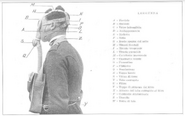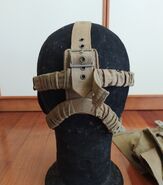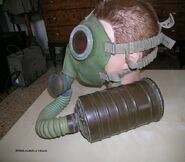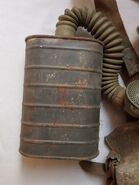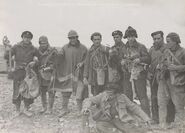The Penna respirator sometimes referred to just as Penna mask, was the first domestic design gas mask adopted by the Italian Army after the Great War, succeeding the English SBR. The mask was named after Lorenzo Penna, the Generale del Genio (military engineering general) who founded the S.C.M. (Servizio Chimico Militare, chemical military service).
Mask overview[]
The Penna mask's faceblank was made of a two layers rubber, green and textured on the outside while beige and smooth on the inside. Inside the mask there was a bizygomatic arched septum made of rubber and synthetic sponge, which separated the faceblank in two parts, reducing dead space and helping to prevent fogging while wearing the mask. The faceblank had the following parts attached:
- The head harness, with six elastic straps. Modified models have only 5 straps and use the M.31-style harness
- The "Triplex" eyepieces were made of three layers, two glass ones and a cellulose one that tended to become orange over time. To even to prevent fogging, anti-fogging lenses could be put using eye clips
- The inlet-outtake piece was connected to the mask at the bottom and tends not to point straight forward but to bend to one side because of the soft rubber. It has three holes: one for the hose, one for the connection to the mask and the third was for the exhale valve, an aluminium disc with two complementary thin rubber discs kept still by a lid and sealed with a rubber ring; inside there was an inlet valve to allow a longer duration of the filter.
- The filter itself was attached through a pleated hose to the aforementioned piece and itself was stored in its bag.
6-straps variant[]
Modified (5-straps) variant[]
Filter[]
Original filter[]
The original Penna mask was provided with a large box filter coloured grey-green. This filter is often referred to as "Piatto", which means flat, as it's the only Italian military filter to not be round.
There is a marking on one side which can be one of the following:
- "E", meaning that the filter is fit only of training
- "R" followed by a star, which means that the filter can be used both for training and actual threats
- "A" followed by a star, meaning the filter was to be used exclusively for mobilisation
The contents of the filters, from top to bottom, are the following:
For the "E" filter:
- cotton layer
- activated charcoal layer (A type peat charcoal)
- cotton layer
For the "R" filter:
- cotton layer
- activated charcoal layer (A type peat charcoal)
- cotton layer
- a layer of pumice granules soaked in sodium carbonate and potassium permanganate
- cotton layer
For the "A" filter:
- cotton layer
- activated charcoal layer (A type peat charcoal)
- cotton layer
- a layer of Z type granules (zinc oxide-carbonate, sodium and activated charcoal powder)
- cotton layer
The autonomy for those filters was believed to be around 30 to 40 hours. Due to the inability of cotton to filter arsines properly, these layers would be changed to the C type smokeproof mass on the M.31 filter.
M.31 and M.33 filters[]
During later use, the mask was connected to an M.31 or M.33 filter.
Standard kit[]
The standard kit consisted of the following:
- The mask itself, initially the 6-straps variant but later only the 5-straps variant
- The filter, initially only the original ones but later on M.31-33 filters, which would not replace the former completely though, especially for training
- The bag, made usually of green (rarely brown) rubberized cloth. The filter section had holes to allow airflow. Inside the side pocket, there were a pair of anti-fogging lenses, specifically made for this mask. The main strap had a special buckle to be shortened when the mask was in use; the small string on the side of the bag helped to keep the aforementioned firmly onto the wearer's chest. Some kits had the bag replaced with an M.31-33 one, in case the first broke.
- At least a set of Penna anti-fogging lenses
Some kits may sport unusual bags and repairs to the facepiece, as some were modified by the Republicans and possibly used after the Spanish Civil War.
Service life[]
Adoption[]
During the late '20s, the Italian Army was seeking renovation in its chemical protection equipment. Since the end of the war, in fact, the Army was still using Small Box Respirators, which were considered outdated by every standard after the second half of the '20s. Because of that push, the army adopted the Penna respirator in 1928, naming it after the deceased general Lorenzo Penna. It resembled the SBR functionally but had a very different construction. This mask was made integrally of rubber, which was something quite uncommon at the time, it had Triplex glasses and an internal divider, a feature that was almost unseen in military masks at the time.
Problems and replacement[]
Even though this mask had very innovative features, it had some problems in its design, which are in order of decreasing severity:
- The soft rubber made the inlet-outtake piece wobble too much, restraining airflow and encumbering respiration
- The inlet and exhale valves were not as easily replaceable as deemed necessary, and the same goes for the eyepieces and straps, both of which required special tooling to be replaced
- The filter plug system wasn't practical and the plugs could be easily lost.
Because of these reasons, the Army adopted the M.31 in 1931, which fixed these problems and others too. The Penna, therefore, started slowly being ruled out of service.
The 5-straps upgrade[]
In 1929/1930 the Penna respirators were upgraded with a new 5-points elastic head harness, which would become standard in Italian military masks. To switch to the new set-up, the masks were deprived of the old harness by ungluing the 4 lower straps and by cutting the rubber where the two upper straps were held. This process was executed to almost all masks, making Penna respirators with the original setup extremely rare. The main use to the newly upgraded Penna respirators was to train soldiers in the use of gas masks, and they were issued with their old bag and an M.33 filter. On rare cases, Penna masks were used for second-line duties, like terrestrial navy units, and in even rarer cases they were used by Italian soldiers or native rebels during the Spanish civil war.
Spanish civil war use[]
During the Spanish Civil War, a great number of Italian masks were imported into Spain (318.908), most, if not all of these, were T.35s, which were adopted under the designation of "Modelo L". A lot of the Italian masks that enterd the coutry did so by being brought by the Italian voluntary corp, who mostly issued M.31-33s and Penna respirators.
Author's note: it's unclear whether the M.31-33s and Pennas that entered the country came all from the volunteering soldiers or partially from the 318.908 gas masks imported to be used by the Nationalists.
These masks were occasionally captured by the Republicans (especially during the battle of Guadalajara in March 1937), who sometimes reissued them. The kits they'd be issued with could either be the normal or slightly modified: the hoses could be switched around with M.31-33 masks, and the bag could get replaced with incorrect ones, such as T.35 bags, random knapsacks, or carriers for other gas masks. When a part of the mask had to be attached back with tape (for example, when replacing a hose), the materials used would be the following: tape, wire, red string and then tape again, covered in blue paint afterwards. It's unclear whether white tape was ever used over the seams between the faceblank and the straps like with Spanish M.31-33s, and if it was, whether it was done during the War or not.
Post-Civil War Spanish use[]
Author's note: This section of the article is speculative and purely based on circumstantial evidence, as it's unlikely that any source will be able to either prove or disprove these claims.
After the end of the Spanish Civil War, there was a substantial surplus of respirators, among which there were large numbers of T.35s and M.31-33s. These two would be adopted by the spanish army respectively under the designations L.T.35 and L.M.33, with manuals describing their characteristics, variability and kits. Generally, when classifying Civil War surplus masks, those that were either damaged beyond repair or not compliant with the characteristics any of the 7 most common models would be classified as "Inútil" (useless). The Penna respirator was present in much lower numbers than the T.35s and M.31-33s, so it didn't warrant its own designation and was theoretically "Inútil", but, due to the strong similarity to the M.31-33 in doctrine, it's possible that some, or even all of the recovered ones, were adopted under the L.M.33 designation.
The three key differences with the regular L.M.33s were the following:
- The internal septum was different from the black oral-nasal cup used in M.31-33s
- The exhale valve was composed of a seating and a valve, and also required a gasket to work
- The eyepieces were fixed in place and not replaceable in the same way as M.31-33s
The first difference mentioned was impossible and/or impractical to modifiy to fit the standard of the L.M.33, but it still retained the same function more or less and therefore was not much of an issue. The second difference was easier to fix, as the housing for the exhale valve was fully compatible with L.M.33 and L.T.35 exhale valves, which would replace the composed exhale valve and make the gasket redundant (this modification could be done in any warehouse). As for the third difference, eyepiece replacement for L.M.33s was regarded as a second grade repair done only in specialised plants, in which specialized tools were available; the Penna repirators that were supposedly used as L.M.33 kits have had their fixed lens holders removed in order to be able to mount M.31-33 lens holders. In conclusion, a Penna respirator used in an L.M.33 configuration had eyepieces modified to use M.31-33 lens holders and an L.M.33 or L.T.35 exhale valve. Further modifications and repairs done to both the mask and the kit can be read from the section of the M.31-33 article dedicated to the L.M.33.

